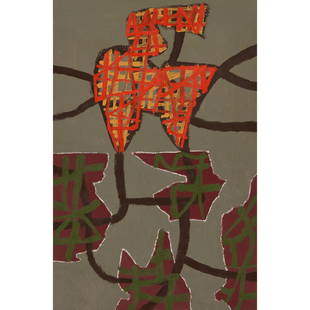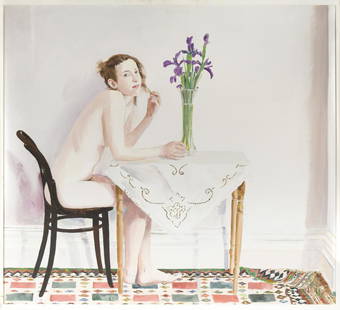
TRISTRAM HILLIER, R.A. (BRITISH 1905 - 1983) Étretat, 1939 Oil on canvas, 60 x 80cm (23¾ x
Similar Sale History
View More Items in PaintingsRelated Paintings
More Items in Paintings
View MoreRecommended Art
View More




Item Details
Description
TRISTRAM HILLIER, R.A. (BRITISH 1905 - 1983) Étretat, 1939 Oil on canvas, 60 x 80cm (23¾ x 31½) Signed 'Hillier' (lower left); inscribed and dated 'ETRETAT 1939' (on the reverse) Provenance: With Arthur Tooth & Sons, London, where purchased by the present owner's family. Exhibited: London, Arthur Tooth & Sons Ltd, 7th May - 1st June 1946, Paintings of Tristram Hillier, (catalogue record no. unknown); Bradford, Bradford Art Galleries and Museums, June 11 - 31 July 1983, A Timeless Journey: Tristram Hiller R.A 1905 - 1983, cat. no.18 (illustrated p.21 & catalogue description p.44) The beach with its drying nets and jet-black fishing boats etched against the luminous Norman sky, and throwing deep translucent shadows upon the shingle, excited me enormously and formed the subject for what I considered some of the best paintings I have ever made.[1] Hillier’s reference to that ‘luminous Norman sky’ describes the time he spent in the town of Étretat on the northwestern coast of France. It was a place that fulfilled him greatly as an artist and provided constant inspiration during the three years he spent living there. His draw to the place was shared with many other painters and Étretat had long been considered an artistic haven, attracting the likes of Delacroix, Courbet and Monet. The latter of which stayed at the Hotel Blanquet, the very same one that appears in this present work. During his time there Monet made repeated images of the infamous arches of the white chalk cliffs, representing cycles within a landscape depicted at different times of the day, of the year or from a variety of perspectives. In this work Hillier has positioned himself and our viewpoint from one of the jutting cliff faces that form part of the second arch of Porte d’Aval. We are looking down over the town and beach front of Étretat, and the third arch, Porte d’Amont, is visible in the distance. Atop of that cliff sits the church Notre-Dame-de-la-Garde and behind it the original monument to the L’Oiseau Blanc (White Bird) which commemorated the failed voyage of the biplane that disappeared in 1927 during an attempt to make the first non-stop transatlantic voyage. The monument depicted by Hillier was destroyed by the occupying German army in 1942. The town is populated with brick and stone buildings and British, American and French flags fly proudly in the wind, particularly pertinent in relation to the change that will overcome this small commune in Normandy in the following year. The beachfront is dotted with multicoloured cabins and upturned fishing boats. Holidaymakers either sun themselves on the sand or relax on the balcony overlooking the beach, under large umbrellas. On the cliff face a pair of couples enjoy the fresh air. The ‘deep translucent shadows’ Hillier referred to are abundant in the work, the sun at its highest point casting sharp silhouettes across the sand. While this work is different to other examples of the period, which are more straightforwardly ‘Surrealist’ in character, there are certain elements which persist. Hillier seems to be presenting us with an idyll on the cusp of collapse, locals and tourists alike enjoying the last of the peacetime. The two couples now appear to be more putting on a show of elegance and enjoyment for our benefit, dressed up as characters. In this work narrative elements are left unexplained, isolated from each other within this large composition. The scale of the work is also unusual, given his other works of this period, which are tighter and more constrained. A large portion of the composition is taken over with an expanse of blue sky, while the cliff face, town and beachfront occupy a small fraction of the overall composition. It serves to create a broad expansive panorama, infusing the scene with a more dramatic element than otherwise might have been achieved with a smaller composition. Other examples of his work while living in Étretat follow a more sinister note, though still working within the theme of the seaside and marine life. These works may suggest a greater awareness or acceptance of the impending threat of violence, darker in tone and showing empty beaches, no longer enjoyed by holiday makers or used by local fishermen. Such as The Beach at Yport (fig 1), another seaside port up along the coast which Hillier visited many times, or Fishing Craft at Étretat 1939 (National Gallery of Canada). A recurring theme of abandonment is typical of his paintings of this period. Objects are washed up on beaches, items of clothing left behind and by focusing in on them and using them as props, they are shown out of context in order to produce an element of visual suspense. Hillier had settled in Normandy in 1937 with his second wife Leda. They had met while both were travelling through Austria. She was there with her father Captain Sydney Hardcastle, a retired Anglo-Irish naval engineer. The two married soon after meeting, Hillier was apparently strongly attracted to Leda’s solid ‘country’ values.[2] Leda’s mother, who died shortly after her daughter’s birth, was from County Cork and Leda had spent her childhood in the south of Ireland looked after by her aunts. In the village of Criquetot-l’Esneval near Étretat they came upon a wonderful 18th century house called l’Ormerie which is beautifully depicted in The Painter at Home (1940) (fig 2) showing the newly married couple and their two dogs surrounded by the elm trees from which the house derived its name. As they could not afford the property themselves, Leda’s father generously purchased the house for them. However, their French idyll ended abruptly when they were compelled to flee the town in the early summer of 1940 with the very near threat of German invasion from advancing forces. Once the war ended the Hilliers were immediately travelling again, first to Normandy in September 1945 to see their abandoned home. Their maid Henriette filled them in on how l’Ormerie, in their absence, was ransacked by the German forces. Thankfully for Hillier, Henriette had removed the paintings from his studio and hidden them in the house of a neighbour, Monsieur Layet. Hillier reveals in letters to Dudley Tooth in May 1945 that they were kept in Monsieur Layet’s house for the duration of the war before being handed over to his lawyer Monsieur Maujean. The recovery of the paintings was very important particularly from an economic standpoint, providing much needed financial support for the family. Following a period of intense negotiation with the Board of Trade in the UK, they were finally granted permission for the pictures painted prior to his departure from France to be imported into the UK. There were 51 artworks in total to be shipped, including this present example. They left Étretat bound for London on 7th March 1946. Arrangements were made for an exhibition of the works with his dealer Dudley Tooth of Arthur Tooth & Sons, which had initially been planned for 1940. The exhibition ran from May 7th - June 1st, 1946, at their gallery on 31 Bruton Street. It was a hugely successful show for Hillier and he sold all of the works. Hillier wrote of it, 'My exhibition was as successful as I could have wished. All the pictures were sold within a few days while the critics were in some cases complimentary and in others exceedingly abusive, so that their reactions were without exception gratifying'.[3] Another condition of the import license was that Hillier would take up permanent residency in the UK, and the family settled in Somerset. He continued to enjoy trips abroad, particularly in Spain and Portugal and closer to home he spent time in Ireland. Travel was a refuge for Hillier, an opportunity to escape his ordinary life and it fed his artistic output greatly. A wonderful work made in 1947, shortly after his return from France, depicts the harbour in Galway city (fig 3). A Guinness brewery is visible in the distance, Hillier once again employing elem
Buyer's Premium
- 30%
TRISTRAM HILLIER, R.A. (BRITISH 1905 - 1983) Étretat, 1939 Oil on canvas, 60 x 80cm (23¾ x
Estimate €40,000 - €60,000
2 bidders are watching this item.
Shipping & Pickup Options
Item located in Ireland, Dublin, ieSee Policy for Shipping
Local Pickup Available
Payment

TOP






































































